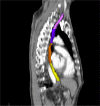Clinical, dosimetric, and position factors for radiation-induced acute esophagitis in intensity-modulated (chemo)radiotherapy for locally advanced non-small-cell lung cancer
- PMID: 30288052
- PMCID: PMC6160279
- DOI: 10.2147/OTT.S174561
Clinical, dosimetric, and position factors for radiation-induced acute esophagitis in intensity-modulated (chemo)radiotherapy for locally advanced non-small-cell lung cancer
Abstract
Purpose: The purpose of this study was to estimate the relation between acute esophagitis (AE) and clinical, dosimetric, and position factors in patients with locally advanced non-small-cell lung cancer (NSCLC) receiving intensity-modulated (chemo)radiotherapy.
Materials and methods: A retrospective cohort analysis was performed to identify factors associated with Common Toxicity Criteria for Adverse Events grade 2 or worse AE (AE2+). A multivariable model was established including patient- and treatment-related variables and esophageal dose-volume histogram parameters. The esophagus was divided according to physiological anatomy, and logistic regression was used to analyze the position parameter for its correlation with AE2+.
Results: The incidence of AE2+ was 27.5%. All models included gender, concurrent chemo-radiotherapy (CCRT), position parameter, and one of the dosimetric variables. The model with mean dose showed the best goodness of fit. Gender (OR=2.47, P=0.014), CCRT (OR=3.67, P=0.015), mean dose (OR=1.33, P<0.001), and maximum radiation position (OR=1.65, P=0.016) were significantly related to AE2+.
Conclusion: Gender, concurrent chemotherapy, maximum radiation position, and mean dose were independent risk factors for AE2+. The upper part of the esophagus showed a higher sensitivity to radiation toxicity.
Keywords: acute esophagitis; intensity-modulated radiation therapy; non-small-cell lung cancer; position parameter.
Conflict of interest statement
Disclosure The authors report no conflicts of interest in this work.
Figures
Similar articles
-
Acute esophagitis for patients with local-regional advanced non small cell lung cancer treated with concurrent chemoradiotherapy.Radiother Oncol. 2016 Mar;118(3):465-70. doi: 10.1016/j.radonc.2016.01.007. Epub 2016 Jan 20. Radiother Oncol. 2016. PMID: 26803187 Clinical Trial.
-
Multivariable normal-tissue complication modeling of acute esophageal toxicity in advanced stage non-small cell lung cancer patients treated with intensity-modulated (chemo-)radiotherapy.Radiother Oncol. 2015 Oct;117(1):49-54. doi: 10.1016/j.radonc.2015.08.010. Epub 2015 Sep 2. Radiother Oncol. 2015. PMID: 26341608
-
Predictors of radiation-induced esophageal toxicity in patients with non-small-cell lung cancer treated with three-dimensional conformal radiotherapy.Int J Radiat Oncol Biol Phys. 2003 Feb 1;55(2):337-41. doi: 10.1016/s0360-3016(02)03937-8. Int J Radiat Oncol Biol Phys. 2003. PMID: 12527046
-
Acute esophageal toxicity in non-small cell lung cancer patients after high dose conformal radiotherapy.Radiother Oncol. 2005 May;75(2):157-64. doi: 10.1016/j.radonc.2005.03.021. Radiother Oncol. 2005. PMID: 15890421 Clinical Trial.
-
Radiotherapy and chemotherapy in locally advanced non-small cell lung cancer: preclinical and early clinical data.Hematol Oncol Clin North Am. 2004 Feb;18(1):41-53. doi: 10.1016/s0889-8588(03)00138-2. Hematol Oncol Clin North Am. 2004. PMID: 15005280 Review.
Cited by
-
Research progress of radiation esophagitis: A narrative review.Medicine (Baltimore). 2025 May 9;104(19):e42273. doi: 10.1097/MD.0000000000042273. Medicine (Baltimore). 2025. PMID: 40355243 Free PMC article. Review.
-
Using inflammatory indexes and clinical parameters to predict radiation esophagitis in patients with small-cell lung cancer undergoing chemoradiotherapy.Front Oncol. 2022 Nov 22;12:898653. doi: 10.3389/fonc.2022.898653. eCollection 2022. Front Oncol. 2022. PMID: 36483030 Free PMC article.
-
Dosimetric risk factors for radiation esophagitis in patients with breast cancer following regional nodal radiation.World J Clin Cases. 2024 Jun 16;12(17):2995-3003. doi: 10.12998/wjcc.v12.i17.2995. World J Clin Cases. 2024. PMID: 38898857 Free PMC article.
-
Validation of Polymorphisms Associated with the Risk of Radiation-Induced Oesophagitis in an Independent Cohort of Non-Small-Cell Lung Cancer Patients.Cancers (Basel). 2021 Mar 22;13(6):1447. doi: 10.3390/cancers13061447. Cancers (Basel). 2021. PMID: 33810047 Free PMC article.
-
Radiomic and dosimetric parameter-based nomogram predicts radiation esophagitis in patients with non-small cell lung cancer undergoing combined immunotherapy and radiotherapy.Front Oncol. 2024 Dec 18;14:1490348. doi: 10.3389/fonc.2024.1490348. eCollection 2024. Front Oncol. 2024. PMID: 39744008 Free PMC article.
References
-
- Palma DA, Senan S, Oberije C, et al. Predicting esophagitis after chemoradiation therapy for non-small cell lung cancer: an individual patient data meta-analysis. Int J Radiat Oncol Biol Phys. 2013;87(4):690–696. - PubMed
-
- Caglar HB, Othus M, Allen AM. Esophagus in-field: a new predictor for esophagitis. Radiother Oncol. 2010;97(1):48–53. - PubMed
-
- Bradley J, Deasy JO, Bentzen S, El-Naqa I. Dosimetric correlates for acute esophagitis in patients treated with radio therapy for lung carcinoma. Int J Radiat Oncol Biol Phys. 2004;58(4):1106–1113. - PubMed
LinkOut - more resources
Full Text Sources


